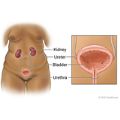Condition Overview
What is urinary incontinence?
Urinary incontinence is the accidental release of urine. It can happen when you cough, laugh, sneeze, or jog. Or you may have a sudden need to go to the bathroom but can't get there in time. Bladder control problems are very common, especially among older adults. They usually don't cause major health problems, but they can be embarrassing.
Incontinence can be a short-term problem caused by a urinary tract infectionurinary tract infection, a medicine, or constipation. It gets better when you treat the problem that is causing it. But this topic focuses on ongoing urinary incontinence.
There are two main kinds of urinary incontinence. Some women—especially older women—have both.
- Stress incontinence occurs when you sneeze, cough, laugh, jog, or do other things that put pressure on your bladderpressure on your bladder. It is the most common type of bladder control problem in women.
- Urge incontinence happens when you have a strong need to urinate but can't reach the toilet in time. This can happen even when your bladder is holding only a small amount of urine. Some women may have no warning before they accidentally leak urine. Other women may leak urine when they drink water or when they hear or touch running water. Overactive bladder is a kind of urge incontinence. But not everyone with overactive bladder leaks urine.
What causes urinary incontinence?
Bladder control problems may be caused by:
- Weak muscles in the lower urinary tracturinary tract.
- Problems or damage either in the urinary tract or in the nerves that control urination.
Stress incontinence can be caused by childbirth, weight gain, or other conditions that stretch the pelvic floor musclespelvic floor muscles. When these muscles can't support your bladder properly, the bladder drops down and pushes against the vagina. You can't tighten the muscles that close off the urethraurethra. So urine may leak because of the extra pressure on the bladder when you cough, sneeze, laugh, exercise, or do other activities.
Urge incontinence is caused by an overactive bladder muscle that pushes urine out of the bladder. It may be caused by irritation of the bladder, emotional stress, or brain conditions such as Parkinson's disease or stroke. Many times doctors don't know what causes it.
What are the symptoms?
The main symptom is the accidental release of urine.
- If you have stress incontinence, you may leak a small to medium amount of urine when you cough, sneeze, laugh, exercise, or do similar things.
- If you have urge incontinence, you may feel a sudden urge to urinate and the need to urinate often. With this type of bladder control problem, you may leak a larger amount of urine that can soak your clothes or run down your legs.
- If you have mixed incontinence, you may have symptoms of both problems.
How is urinary incontinence diagnosed?
Your doctor will ask about what and how much you drink. He or she will also ask how often and how much you urinate and leak. It may help to keep track of these things using a bladder diary for 3 or 4 days before you see your doctor.
Your doctor will examine you and may do some simple tests to look for the cause of your bladder control problem. If your doctor thinks it may be caused by more than one problem, you will likely have more tests.
How is it treated?
Treatments are different for each person. They depend on the type of incontinence you have and how much it affects your life. After your doctor knows what has caused the incontinence, your treatment may include exercises, bladder training, medicines, a pessary, or a combination of these. Some women may need surgery.
There are also some things you can do at home. In many cases, these lifestyle changes can be enough to control incontinence.
- Cut back on caffeine drinks, such as coffee and tea. Also cut back on fizzy drinks like soda pop. And don't drink more than one alcohol drink a day.
- Eat foods high in fiber to help avoid constipation.
- Don't smoke. If you need help quitting, talk to your doctor about stop-smoking programs and medicines. These can increase your chances of quitting for good.
- Stay at a healthy weight.
- Try simple pelvic-floor exercises like Kegel exercisesKegel exercises.
- Go to the bathroom at several set times each day, and wear clothes that you can remove easily. Make your path to the bathroom as clear and quick as you can.
- Keep track of your symptoms and any leaking of urine with a bladder diary. This can help you and your doctor find the best treatment for you.
If you have symptoms of urinary incontinence, don't be embarrassed to tell your doctor. Most people can be helped or cured.
How can you prevent urinary incontinence?
Strengthening your pelvic muscles with Kegel exercises may lower your risk for incontinence.
If you smoke, try to quit. Quitting may make you cough less, which may help with incontinence.


